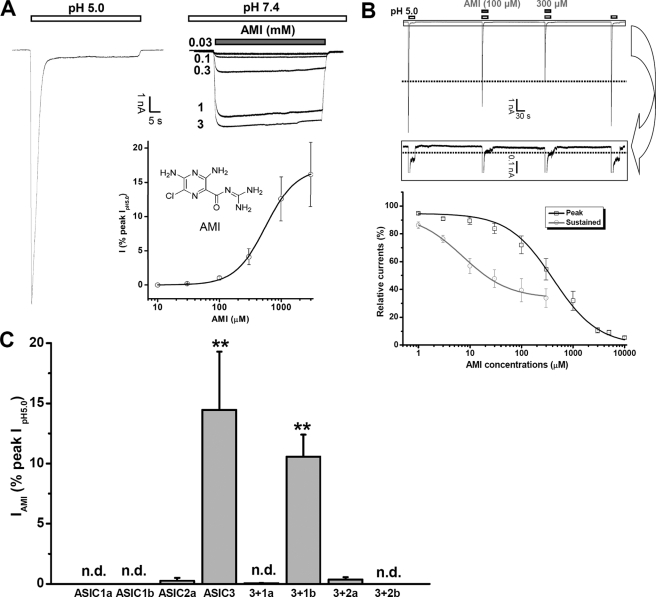FIGURE 1.
Effects of AMI on ASIC3 channels. A, chemical structure of AMI and AMI-activated ASIC3 currents. AMI dose-dependently evoked inward currents in ASIC3-transfected (right panel) but not in nontransfected CHO cells (data not shown). Although the acid (pH 5.0)-induced current desensitized rapidly (left panel), little desensitization was observed for the AMI-evoked currents (above right panel). Similar results were obtained in six other experiments. Concentration-response relationship of AMI is shown below right panel. Each point is the mean ± S.E. of seven measurements normalized to the pH 5.0-induced peak currents, and the solid line was the fit to the Hill equation. The EC50 and n values of AMI are 0.56 ± 0.02 mm and 1.76 ± 0.07, respectively. B, effects of AMI on the activation of ASIC3 channels by acid (pH 5.0). AMI dose-dependently inhibited the pH 5.0-induced currents (i.e. both peak and sustained components) of ASIC3 channels as shown in the representative example (upper panel). Data points are means ± S.E. of four to eight measurements normalized to the currents induced by pH 5.0 in the absence of AMI, and the solid lines were the fit to the Hill equation giving an IC50 value of 7.2 ± 1.4 μm (n = 0.97 ± 0.22) for the sustained (gray) and 412.2 ± 2.0 μm (n = 0.86 ± 0.11) for the peak component (black), respectively. C, subunit selectivity of AMI action at the neutral pH. Shown is the summary of AMI (1 mm)-induced currents in CHO cells transfected with one or two different ASIC subunits. AMI activated ASIC3 homomeric channels and heteromeric ASIC3 + ASIC1b channels but not ASIC1a, ASIC1b, or ASIC2a homomeric channels, or heteromeric ASIC3 + 1a, ASIC3 + 2a, or ASIC3 + 2b channels at the neutral pH. Data are means ± S.E. n = 3–5. n.d., no detectable response to AMI. **, p < 0.001 versus base-line level.

